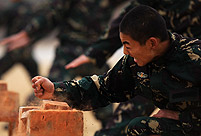Tujia is an ancient ethnic group in China who call themselves “native dwellers.” Their worship of creation myths and white tigers is still evident in their songs, dances and home decorations.
The Tujia ethnic group has a population of over 8 million, and mainly lives in compact communities in the Wuling Range of western Hunan and Hubei provinces. There are also Tujia people scattered in Sichuan Province and other regions in China.
The Tujia people call themselves Bizika, which means “native dwellers.” Though their name suggests that they are natives, their exact origin is still uncertain. Some people trace their ancestry to the ancient Ba people. Others claim they come from the Wuman, who moved to western Hunan from Guizhou Province, and another theory is that they came from Jiangxi Province at the end of the Tang Dynasty (AD 618-907).
In any case, the Tujias were a distinct ethnic group in western Hunan by the early Five Dynasties period, around the year 910. The Tujia ethnic group was officially recognized as one of the 55 ethnic groups in 1957 by the Chinese government.
Like many minority groups in China, the Tujia people believe in the power of ancestors and gods. White tiger worship is quite significant among the group as they call themselves “Offspring of the White Tiger.” The belief sprang from a legend about an ancient leader of Tujia defeating enemies and helping his people settle down. He gained respect and esteem of his people and he turned into a white tiger after his death.
Statues of white tigers can still be found in homes of most Tujia families as a protector. And the white tiger worship also can be seen in their wedding decorations and traditional dances.
The Tujia language belongs to the Tibeto-Burman group of the Sino-Tibetan language family, yet it is only used in a few areas today. Since there are no written version of the Tujia language, the language of the Han is most often used among Tujia people.
Handmade cloth is used in the traditional dress of both Tujia women and men. The traditional cloth is woven by Tujia women in more than 100 colorful patterns.
Tujia women traditionally dress in jackets trimmed with lace and short, broad sleeves. They wear long skirts, and wrap their coiled hair in cloth. The women also love to adorn themselves with necklaces, earrings, bracelets and ankle bracelets.
Tujia men traditionally wear short jackets with buttons in front.
Songs and dance play an important role in Tujia culture as a way to tell epic sagas and creation myths, as well as expressing love and grief.
Baishou dance, or hand dance, is one of the most popular dances of the Tujia ethnic group. The dance has a history of over 500 years. With its origin as a dance of triumph, the traces of war, hunting, farming and feasting can still be found among the 70 ritual gestures in the dance. Baishou dance is done in a traditional collective performance that Tujia people often present on festivals like at the new year.
Tujia girls traditionally welcomed their wedding day by crying, which could last from five days to a month beforehand. Usually, the bride would not cry alone but be accompanied by her female relatives and friends. Tujia people judge a girl’s intelligence and virtue by how well she could sing crying songs at the wedding. The tradition gradually has faded, but it is still practiced by some Tujia families in remote regions.
Rice, corn, wheat and sweet potatoes are among the common foods for Tujia people. Bean rice, which includes green beans, peas and rice, also is popular. During the busy farming season when heavier labor is required, an extra meal is often added in the morning, made up of snacks like tangyuan (glutinous sweet dumplings), or mungbean starch.
Ciba (glutinous rice cakes) and pork are considered essential for festival feasts. Ciba are made of glutinous rice and shaped into palm-sized cakes. Ciba are baked until the surface takes on a burned color. Then the dust is wiped off and honey or white sugar is used to fill the ciba before they are served with both hands to the guests.
For Tujia people, the new year is the biggest festival. It is called Gannian or Diaonian Meeting, and is celebrated one day before the Lunar New Year of the Han people. Tujia people prepare sumptuous dinners and hold activities like dance and singing as part of the celebration. The festivities may last 10 days.
The Sheba Festival is another important event that is celebrated from the third day to the 17th day of the first month in the Chinese lunar calendar. It is for worshipping the ancestors, and wishing for a prosperous year. It is also a good opportunity for young people to make friends and find love. The Tujia people traditionally wear their holiday best and bring sacrifices and wine. The young men gird themselves with broadswords. Bonfires, the firing of shots, singing and dancing fill the day.
 Luxury-cars parade held in Dubai
Luxury-cars parade held in Dubai Special forces take tough training sessions
Special forces take tough training sessions Fire guts 22-storey Nigeria commercial building in Lagos
Fire guts 22-storey Nigeria commercial building in Lagos A girl takes care of paralyzed father for 10 years
A girl takes care of paralyzed father for 10 years A record of Beijing air quality change
A record of Beijing air quality change In pictures: explosions occur in Taiyuan
In pictures: explosions occur in Taiyuan Hello! Horror Halloween Celebration!
Hello! Horror Halloween Celebration!  The catwalk to the world of fashion
The catwalk to the world of fashion  Cruise trip to Taiwan
Cruise trip to Taiwan  Maritime counter-terrorism drill
Maritime counter-terrorism drill Loyal dog waits for master for six months
Loyal dog waits for master for six months Oriental education or western education?
Oriental education or western education? China in autumn: Kingdom of red and golden
China in autumn: Kingdom of red and golden National Geographic Traveler Photo Contest
National Geographic Traveler Photo Contest Chinese screen goddesses from Beijing Film Academy
Chinese screen goddesses from Beijing Film Academy Day|Week|Month